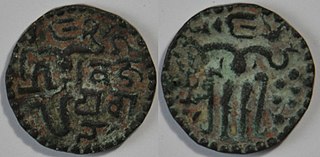
The Sinhala Kingdom or Sinhalese Kingdom refers to the successive Sinhalese kingdoms that existed in what is today Sri Lanka. The Sinhalese kingdoms are kingdoms known by the city at which its administrative centre was located. These are in chronological order: the kingdoms of Tambapanni, Upatissa Nuwara, Anuradhapura, Polonnaruwa, Dambadeniya, Gampola, Kotte, Sitawaka and Kandy.
Alagakkonara, also known as Alakeshwara, were a prominent feudal family that provided powerful ministers and military rulers during the medieval period in Sri Lanka. Some historians claim that the family was of Tamil origin, possibly from Madurai or Kanchipuram in Tamil Nadu, India. The family arrived in Sri Lanka around the 13th century and naturalized themselves in Sri Lanka.

Gampola is a town located in Kandy District, in Sri Lanka's Central Province. The town is governed by an Urban Council. Gampola was made the capital of the island by King Buwanekabahu IV, who ruled for four years in the mid-fourteenth century. The last king of Gampola was King Buwanekabahu V, who ruled the island for 29 years. A separate city was built in Kotte during this time by a noble known as Alagakkonara. The longest sleeping Buddha statue in South Asia is located in the Saliyalapura Temple, Gampola.
Vira Alakesvara, also known as Vijayabahu VI, was the last King of Gampola who ruled from 1397 to 1411. He was the last prominent member of the Alagakkonara family.
Martanda Cinkaiariyan ascended the throne of Jaffna Kingdom under the throne name Pararasasekaram III. He is one of the early Aryacakravarti kings about whom historical and epigraphical evidence is available. He was noted by Ibn Battuta in his well-known travelogue as well as he has left behind a few inscriptions. He oversaw the international trade of the Jaffna kingdom with Yemen via the kingdom's powerful trading ships. Martanda Cinkaiariyan accompanied Battuta to the peak of Sivanoli Padam Malai along with Yogis and other Hindus and companions of the king who visited the sacred Shiva site annually.

The Kingdom of Dambadeniya was a medieval kingdom in what is present-day Sri Lanka. The kingdom's rulers reigned from 1220–1345.

Gampola is a town and once an ancient polity located near Kandy in the Central Province of Sri Lanka. It was made the capital city of the island by King Buwanekabahu IV, who ruled for four years in the mid-fourteenth century. King Buwanekabahu IV ascended the throne after his father and shifted the capital from Kurunegala to Gampola, with the support of General Senalankadhikara.
Dharma Parakramabahu IX was King of Kotte in the sixteenth century, who ruled from 1508/09 to 1513. He succeeded his father Parakramabahu VIII as king of Kotte and was succeeded by his brother Vijayabahu VI.
Parakramabahu VII was King of Kotte in the fifteenth century, who ruled from 1480/1 to 1484. He succeeded his father Bhuvanekabahu VI as king of Kotte and was succeeded by Parakramabahu VIII.
Dharmasoka was an infant King of Polonnaruwa in the thirteenth century, who ruled from 1208 to 1209. He was three months old and installed as king by General Ayasmantha succeeding Kalyanavati as king of Polonnaruwa and was succeeded by his father Anikanga.
Vira Bahu II was King of Gampola who ruled from 1391/2 to 1397. He succeeded Bhuvanaikabahu V and was succeeded by Vira Alakesvara. He may have been succeeded two of his sons in the year 1397.
Parakrama Bahu Epa was King of Gampola who ruled from 1409 to 1412. He succeeded Vira Alakesvara as king and was the last to reign in Gampola.
Parakramabahu V was King of Gampola who ruled from 1344 or 1345 to 1359. He was the Second King of Gampola co-ruling with his brother Bhuvanaikabahu IV, and was succeeded by his nephew Vikramabahu III. Parakramabahu spent his last days as a refugee in the Principality of Ruhuna after the domain was invaded.
Bhuvanaikabahu V was King of Gampola who ruled from 1372/3 to 1391/2. He succeeded his uncle Vikramabahu III as King of Gampola and was succeeded by Vira Bahu II.
Bhuvanaikabahu IV was the first King of Gampola who ruled from 1344/45 to 1353/54. He succeeded his father Vijayabahu V of Dambadeniya and became the King of Gampola. He was succeeded by his brother Parakkamabahu V.

Parakramabahu II, also known as Panditha Parakramabāhu, was the King of Dambadeniya in 13th century, whose reign lasted from 1236 to 1270. As a pioneer in literature, he was bestowed with the honorary title "Kalikala Sahitya Sarvagna Pandita". Parakramabahu's reign is notable for the creation of numerous Sinhalese literal works such as, Kausilumina, Pūjāvaliya, Pāli Vishuddḥi Mārgaya, Thūpavaṃsa and Sidhath Sangarāva. He launched a campaign against the Eastern Ganga invader Kalinga Magha, and successfully expelled him in 1255, unifying Sri Lanka under one rule. He succeeded his father Vijayabahu III as King of Dambadeniya, and was succeeded by his elder son, Vijayabahu IV, after his death.

Vijayabahu IV was King of Dambadeniya in the 13th century, who ruled from 1267/8 to 1270. He succeeded his father Parakkamabahu II as King of Dambadeniya and was succeeded by his brother Bhuvanaikabahu I after being murdered consequent to a conspiracy.
Bhuvanaikabahu II was King of Dambadeniya in the 14th century, who ruled 1310 from to 1325/6. He succeeded his cousin Parakkamabahu III as King of Dambadeniya and was succeeded by his son Parakkamabahu IV.
Vijayabahu V was the last King of Dambadeniya in the 14th century, who reigned from 1325/26 to 1344/45. He succeeded Bhuvanaikabahu III as King of Dambadeniya and was succeeded by Bhuvanaikabahu IV, King of Gampola. He was also known as Savulu Vijayabahu.

The Transitional period of Sri Lanka spans from the end of the Kingdom of Polonnaruwa, in 1232, to the start of the Kandyan period in 1597. The period is characterised by the succession of capitals that followed the fall of the Polonnaruwa Kingdom and the creation of the Jaffna kingdom and Crisis of the Sixteenth Century.







